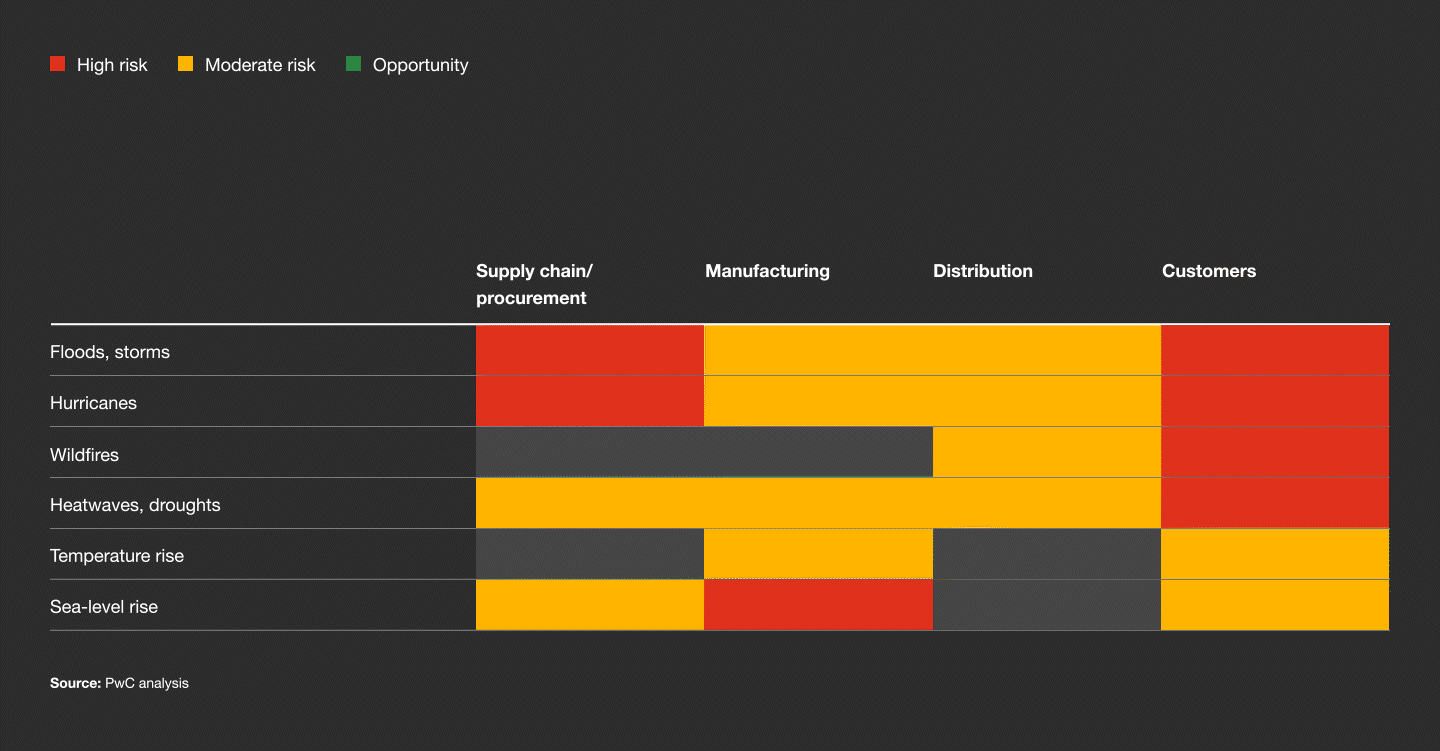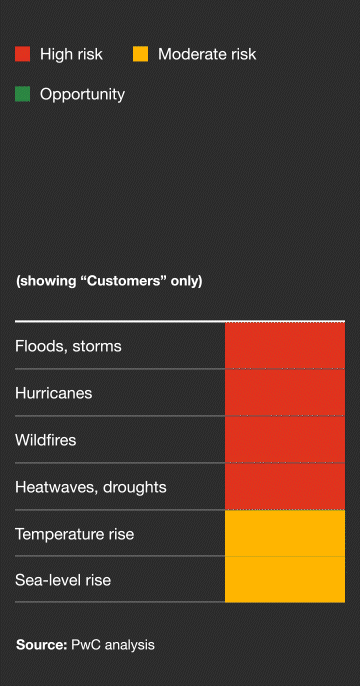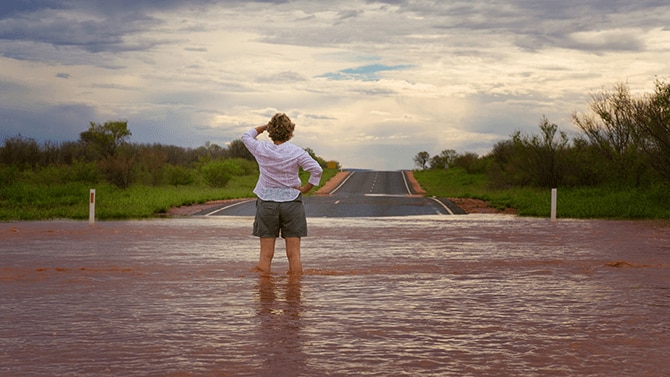The race for net zero has captured the imaginations of countries and companies alike. And not a moment too soon: the latest report from the UN’s Intergovernmental Panel on Climate Change finds that greenhouse gas emissions (GHGs) must peak no later than 2025 to avoid the most dangerous and irreversible effects of climate change.
But even as governments and companies ramp up their decarbonization commitments, there’s another pressing challenge that’s not getting nearly enough management attention. Outside of the most carbon-intensive industries, too few CEOs are looking closely enough at the physical and transition risks that a changing climate poses to their companies. And these risks can be eye-opening. Consider these real-life examples:
- A conglomerate came to learn that extreme weather events could cost it several hundred million dollars a year as soon as 2030. Most of the company’s risk exposure is in its supply chain, and out of its direct control.
- A large retailer identified dozens of its critical facilities at elevated risk of extreme weather, and saw how a global transition to a low-carbon economy could more than double the company’s transportation costs by 2030.
- A global industrial equipment maker learned it must redesign a flagship product and then retrofit its installed base—or else the product is likely to malfunction in areas where climate change is making conditions wetter.
- As drought and declining snowpack levels threaten low-cost hydroelectric power sources in the western United States, a number of technology companies are reappraising their mix of sustainable energy sources to fuel power-hungry data centers.
Climate risks such as these are not only worrying business challenges for CEOs and other leaders, but deeply human challenges, too. One case in point: the massive investments that B2B companies have made in back-office service centers in countries such as India—parts of which face life-threatening heat and humidity spikes in the coming years.
In this article, we’ll highlight how a few companies are using a better understanding of their climate risks (both physical and transition) as a springboard to a more robust and effective climate agenda, one that helps mitigate risks, spot opportunities, and can offer insights into the separate but related challenges of their own decarbonization. Along the way, we’ll explore how the actions and motivations of key stakeholders are pressuring companies to act, and we’ll look at the difficult trade-offs that CEOs must weigh—including those involving the social and human implications of climate change. The transition ahead needs to be both swift and just.
Start with climate risk
In our conversations with CEOs and other senior business leaders, we often encounter a curious disconnect. Leaders know about the looming physical dangers of climate change in a general sense—a litany of climate hazards that includes extreme storms and coastal flooding as well as increased heatwaves, droughts, and wildfires. Indeed, the World Economic Forum’s Global Risks Report 2022 (which tracks the risk perceptions of global leaders in business, government, and civil society) found that “extreme weather” was considered the most likely risk to become a critical global threat over the next two years.
Nonetheless, we find that leaders have much less of an understanding of the specific impact that climate change could have on their business—for example, the physical risks to operations, infrastructure, or to a company’s supply chain, let alone to the business-related transition risks that a societal and economic shift to a decarbonized world would bring (such as changes in demand, the impact on energy prices, building renovation requirements, or potential competitive impacts on logistics chains).
Whether the disconnect is down to the complexity of the problem, the cognitive biases that prevent us from accurately judging probability and risk, or some other mix of factors, we can’t say.
Whatever the cause, climate risks should factor more heavily into a CEO’s thinking, and start informing all of a company’s climate-related decisions. After all, the risks are present whether leaders know it or not. For some companies, extreme weather events and other physical effects of climate change are already having detrimental impacts. It’s therefore a big mistake for senior executives to conclude that these challenges can be put off for another day. And if leaders do think of procrastinating, a range of stakeholders are standing by to refocus corporate attention, as we’ll see next.
Three pressure points
CEOs may not be thinking hard enough about climate risks, but key corporate stakeholders are doing their best to change that. And whether stakeholders’ motivations are informed by climate risk, decarbonization commitments, or both, it’s imperative for business leaders to pay closer attention.
This starts by appreciating the speed at which the stakeholder landscape is changing. Several signs suggest a tipping point that could catch unprepared leaders by surprise—for at least three reasons1 financial institutions are getting serious about finding climate risks hidden in their portfolios; governments are seeking to live up to big decarbonization promises; and sweeping new climate reporting requirements are taking shape quickly—and in some cases are already affecting the real economy. A review of recent developments in these areas—and their implications—can help leadership teams start to challenge old assumptions and prioritize action.
1. Growing financial pressures
Financial institutions of all stripes are getting serious about climate change. For instance, consider the Glasgow Financial Alliance for Net Zero (GFANZ). This coalition of banks, insurance companies, asset managers, and asset owners has pledged to cut emissions from their portfolios and lending to reach net zero by 2050, with an interim target set for 2030. Formed only in late 2021, GFANZ members already represent about US$130 trillion—40% of the world’s financial assets.
Although the most immediate decarbonization impacts are being felt in GHG-intensive industries (coal companies are finding it harder to attract capital, for example, because many financial-services companies have already announced their divestment), the effects are now spreading more widely. Financial institutions are starting to make investment decisions based on the climate-linked risks of their portfolios. Here’s how Christian Ulbrich, the CEO of US-based real estate services company Jones Lang LaSalle, described the challenge in an interview with strategy+business magazine: “There is no easy solution for many buildings because of the way they are constructed—it is financially unattractive to try to decarbonize them. But if you sit on those assets, they’ll very quickly become stranded assets. The speed with which financial institutions are declining to finance those buildings and investors and fund managers are deciding not to buy them is amazing.”
The upshot for CEOs and their leadership teams is clear: the pressure from financial institutions will soon start to touch everything from a company’s credit rating, valuation, and cost of capital to its ability to borrow and get insurance. Too many leaders have not come to grips with the implications of a business world where climate risks are transparent, public, financially material for shareholders, and ultimately part of a board’s fiduciary duty to manage.
2. Stronger government commitments
Governments are also ramping up decarbonization commitments. Today, an astonishing 90% of the global economy falls under a net-zero pledge, up from just 16% in 2019. Such promises can only be met with a massive realignment of economic activity. Although most net-zero commitments target 2050, countries are laying out interim goals and pressuring companies to do likewise. Proposed UK Treasury rules, for example, would force large UK companies by 2024 to detail how they plan to meet their own net-zero targets (with companies in high-emitting sectors doing so in 2023).
Although the prospect of mandates and blockbuster regulatory moves get the lion’s share of corporate attention, a host of seemingly smaller actions could cause C-suite surprises. These include green taxation policies, incentives for innovation, and end-of-life recycling requirements. A recently enacted UK plastic packaging tax, for instance, has caught some manufacturers and importers flat-footed as they race to gather recycled-content data from their extended supply chains, or even from their own operations.
More is on the way. The European Union Green Deal—a group of policies and initiatives adopted in late 2019 to help make Europe the first climate-neutral continent—includes more than 1,000 new or modified levies. At a global level, our PwC colleagues have mapped more than 1,400 environmental taxes and incentives across 88 countries and regions as part of an ongoing research effort. To explore interactive snapshots of 21 of these countries, see Green Taxes and Incentives Tracker on pwc.com.
3. Better nonfinancial reporting
As lenders, asset managers, investors, and insurers get sensitized to the climate risks in their portfolios, they are demanding more transparency from clients and customers. The result is an unprecedented desire for effective nonfinancial reporting.
One popular choice is the Taskforce for Climate-Related Financial Disclosures (TCFD). TCFD was established in 2015 by the Financial Stability Board, and has been embraced by financial institutions, which remain an influential part of the 3,100 companies in 93 countries that now support it. TCFD rules essentially require businesses to identify, manage, and report on climate-related risks—using scenario analysis—as well as to report the level of carbon embedded in the footprint of the business. The TCFD framework provides a useful starting point for companies eager to start understanding the climate risks and opportunities they should anticipate. TCFD reporting is starting to be enshrined in law, first in New Zealand and more recently in Japan and the United Kingdom—with more countries on the way.
Source: The Task Force on Climate-Related Disclosures
Similarly, the European Financial Reporting Advisory Group (EFRAG) and the International Financial Reporting Standards Foundation (IFRS) call for standards that require the reporting of financial vulnerabilities from climate change—in terms of both physical and transition risks.
Not to be outdone, the US Securities and Exchange Commission recently gave initial approval to a rule that would require public companies to disclose annually the “actual or likely material impacts” on the business caused by climate change. The rule—still in draft form—also requires disclosure of a company’s direct and indirect GHG emissions (so-called Scope 1 and Scope 2 emissions). The largest companies would need to go further and report GHGs generated by suppliers and end users (Scope 3 emissions) if these emissions are considered material or are included in other decarbonization targets the company has set.
As these developments suggest, companies have their work cut out for them. Greater scrutiny will increase demand for greater corporate action, as stakeholders start to gain the information they need to reward good climate performance—and penalize poor.
Sidebar
Weathering the storm of climate change
By Robert N. Bernard and Steve Bochanski
The direct operational impact of a weather-related disaster, such as a hurricane or wildfire, can be broad-reaching in terms of physical damage, interruption in business continuity, or supply chain disruption. To understand these and other potential calamities, leaders need a perspective on future projections of weather perils that have a solid grounding in meteorological science and statistics. In the pursuit of such understanding, a range of organizations are ramping up their expertise in climate risk modeling and are hiring climate scientists, geospatial analysts, and software engineers to create, validate, manage, and deploy sound, robust, and tractable weather-peril projections.
Generally, physical risk models start with global climate models of temperature, rainfall, wind, sea level rise, and other attributes. These models span decades into the future and incorporate different scenarios of climate change (each of which is based on a set of actions society takes to mitigate temperature increases, and thus represents a wide range of possible outcomes). Then, climate scientists create scientifically grounded projections of how different weather phenomena will manifest themselves—say, through increased hurricanes, prolonged drought, and widespread wildfires—at different locations across the globe. These projections are compared across climate scenarios and time, with a risk score or probability of occurrence assigned to each weather peril.
Business leaders can then examine their physical assets, their suppliers, and their customers to assess how the likelihood of a weather-related disaster at a particular location has changed. This helps address questions such as:
- What perils does my organization need to prepare for, today and in the future?
- Which of my current and potential investment locations are at greatest risk from weather events, today and in the future?
- What mitigation strategies can I apply to reduce these risks, and which will be most effective?
- How can I incorporate long-term changes in climate conditions into my investment strategy?
Knowing that the projections of weather perils are backed by solid science can give business leaders greater confidence in the decisions they must make to “weather the storm” of climate change.
Facing up to the urgency
Crosscurrents like those just described emphasize how important it is for CEOs to get practical about their own goals and climate ambitions—and quickly. This starts with gaining a better understanding of what a changing climate means for their companies. In our experience, doing so helps leaders develop a better understanding of the science, the implications, the trends, and even the technical language that can help them make better informed decisions. Top management teams will need such understanding—and shareholders, investors, employees, customers, and other stakeholders increasingly will expect it.
The three examples that follow tee up the sorts of lessons that companies learn when they rigorously investigate climate risk, while highlighting the practical steps that organizations can take to improve. As we’ll show, it all starts by taking a close look at the breadth of the company’s value chain, and seeing how the various elements respond to the stresses of science-based climate scenarios. We hope that these examples help serve as inspiration, and if necessary, as a wake-up call for companies that may have been putting off their own analyses under the mistaken assumption that the challenges were safely off in the distant future.
Floods, drought, and new products
A global industrial equipment maker was keen to assess its physical exposure to climate change in the context of better defining a fuller climate agenda. It started with physical risk, by analyzing how its own global operations and those of its key supply chain partners would be affected by a scenario in which the world continued to rely heavily on fossil fuels.
The modeling showed the executives that more than two dozen of the company’s manufacturing and other sites were at elevated risk of flood damage. Three of the sites had already been experiencing problems. Meanwhile, a different two dozen sites were subject to increased drought in the years ahead, which posed risks to the company’s manufacturing operations. Further analysis revealed weaknesses in the company’s supply chain, and instances where materials that it sourced from a single supplier could be in jeopardy.
All told, the analysis helped the company better understand the risks it faced from a changing climate and how they might affect various parts of its value chain (including a detailed financial view). At the same time, the effort helped management generate new strategic options and test its resilience against them.
Finally, while the company learned that it needed to revamp a key product, lest it malfunction in areas experiencing wetter conditions, the effort also identified new products it could develop to help meet rising customer demand for climate-resilient offerings.
A retailer takes stock
A large retailer that wanted to quantify its climate vulnerabilities, given the new TCFD requirements, started by analyzing a range of risks (among them regulation, market, technology, and reputation risks) to see how they might affect key parts of the business under two warming scenarios. The exercise showed company leaders how disruptive the economic transition to a low-carbon economy could be. For example, in one warming scenario, the retailer could face an 18% increase in overall transportation costs by 2030. And when the leadership team factored the company’s growth plans into the equation, the costs more than doubled.
To tackle these climate transition risks, the company began investigating ways to reduce its dependency on conventional road transport, while seeking out new suppliers that were ahead of its current ones in preparing for a green transition. Along with this reconfiguration, the retailer added climate into its strategic calculations in a more robust way—for example, by looking more closely at its approach to delivery, how it might rely more on electrified transport and other greener alternatives, and even how the location of its stores affected its climate transition risk (based in part on how it expected the climate expectations of customers to evolve).
In addition to identifying climate transition risks, the retailer’s deep dive uncovered worrying physical risks. Under one warming scenario, the leadership team saw that dozens of its buildings in three important markets were at heightened risk of storms and floods. The cumulative revenue loss from these events was significant enough to prompt the retailer to look into extending resilience measures in the three markets to help guarantee future insurance coverage. The retailer also promptly began to reflect this new risk assessment in its location selection strategy as well.
A conglomerate finds risk—and opportunity
The conglomerate we highlighted at the beginning of this article began its journey by tasking a cross-functional team with conducting a vulnerability assessment. Using the TCFD framework, the team identified more than three dozen risks and opportunities most relevant to the company’s situation.
Using scenario analysis, the team explored how the company’s prospects might change under different warming scenarios, converting the analysis into a series of heat maps for several of the organization’s key business units. Although some maps showed significant risks, others showed a mix of opportunities, too. Underscoring the difficulties that CEOs face in confronting these issues: in one case, the same physical risks represented a serious challenge for the customers of one business unit, and an opportunity for the customers of another.
Code red: Climate effects on two business units



At the enterprise level, one of the most alarming risks was the potential of several hundred million dollars in revenue declines, starting in 2030. Nearly all of this financial risk was embedded in the company’s supply chain, with a handful of key supplier sites facing a high potential for flooding. Other supplier sites, meanwhile, risked drought.
As part of the management team’s subsequent discussions, the conversation shifted from just managing the risks the company faced to an examination of how the company might turn them into long-term opportunities. Although these conversations are ongoing, one result was a new focus on R&D efforts to develop green products. Leaders also recognized the need to diversify, and the company is now pursuing opportunities in a small—but fast-growing—adjacent market.
The overall effort also had implications for the company’s net-zero goal and decarbonization strategy by giving leaders a fuller picture of the economics from which they could begin to examine the competitive implications of their own decarbonization moves.
Get started—yesterday
As these examples suggest, serious climate risk assessment can help leaders uncover, and prioritize, opportunities to thrive in a climate-challenged world—like the new product ideas identified by the industrial equipment maker, the electrified delivery options spotted by the retailer, and the promising adjacent market that the conglomerate is investigating.
That’s encouraging, because of how urgent the world’s climate challenge is. With further warming, and growing climate risk, already “baked in” under any decarbonization scenario, the time for companies to start getting real about the tangible business risks they face was yesterday. At the same time, the critical importance of curbing emissions, to mitigate even more severe climate impacts, makes decarbonization and business model reinvention mission-critical today. Simply put, leaders need to do both.
In our experience, getting real about climate risk can be a valuable antidote to incrementalism, and a catalyst for the conversation, priority setting, and resource reallocation that the C-suite needs to drive. The good news is that tools for climate modeling and scenario analysis are becoming more sophisticated, enabling a wider swath of organizations to understand their risks. But the clock is ticking—both for the planet and for individual companies. Those companies that build an understanding faster will have more strategic degrees of freedom than their competitors as they plan for climate risks, decarbonize, and reimagine how they will create value for years to come.
Note:
1. These three developments, to be sure, represent an incomplete list. Other important stakeholder pressures that are outside the scope of this article include the value-chain pressures that companies feel—and exert—in service of achieving climate objectives, as well as the impact of rising employee and customer interest, which we believe will increasingly affect a company’s reputation, brand, and ability to attract customers.
Want to take “Time to get serious about the realities of climate risk” with you? Download as PDF
Are you ready for the ESG revolution?
Societal need and business opportunity are coming together to transform the way companies craft strategy, drive performance, and report results.
Get in touch
Reach out to start a conversation

Emma Cox
Global Climate Leader, PwC United Kingdom

Colm Kelly
Global Leader, Corporate Sustainability, PricewaterhouseCoopers International Limited
The Leadership Agenda
Sharp, actionable insights curated to help global leaders build trust and deliver sustained outcomes. Explore our latest content on the global issues affecting organisations today from ESG to value creation, technology and cyber to workforce transformation.
Explore now


















